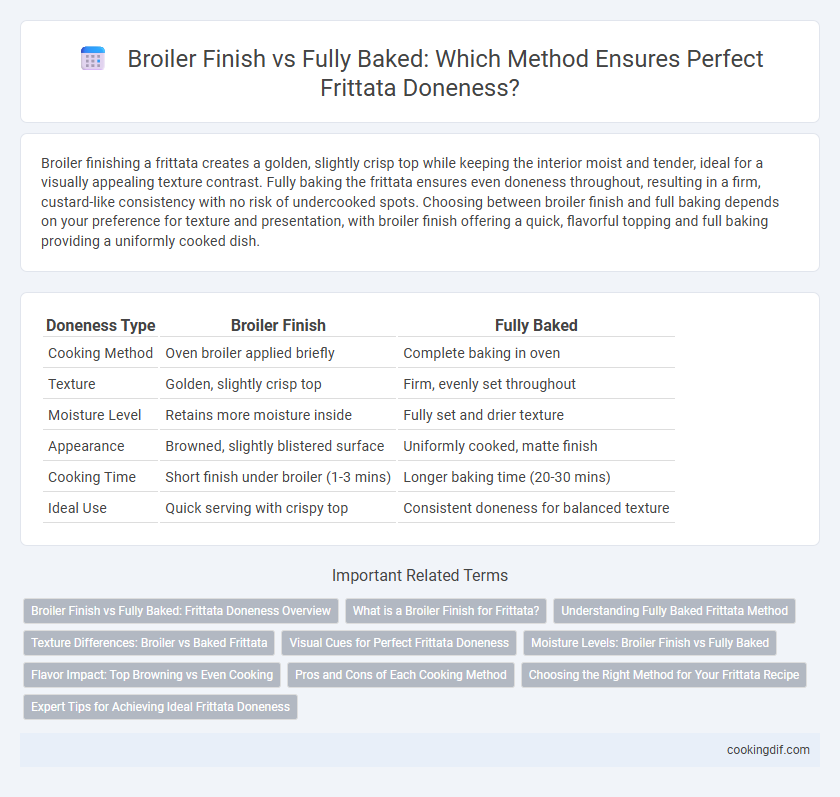Broiler finishing a frittata creates a golden, slightly crisp top while keeping the interior moist and tender, ideal for a visually appealing texture contrast. Fully baking the frittata ensures even doneness throughout, resulting in a firm, custard-like consistency with no risk of undercooked spots. Choosing between broiler finish and full baking depends on your preference for texture and presentation, with broiler finish offering a quick, flavorful topping and full baking providing a uniformly cooked dish.
Table of Comparison
| Doneness Type | Broiler Finish | Fully Baked |
|---|---|---|
| Cooking Method | Oven broiler applied briefly | Complete baking in oven |
| Texture | Golden, slightly crisp top | Firm, evenly set throughout |
| Moisture Level | Retains more moisture inside | Fully set and drier texture |
| Appearance | Browned, slightly blistered surface | Uniformly cooked, matte finish |
| Cooking Time | Short finish under broiler (1-3 mins) | Longer baking time (20-30 mins) |
| Ideal Use | Quick serving with crispy top | Consistent doneness for balanced texture |
Broiler Finish vs Fully Baked: Frittata Doneness Overview
Broiler finish creates a golden, slightly crisp top layer on a frittata, enhancing texture and appearance without overcooking the interior. Fully baked frittatas cook evenly throughout, resulting in a uniform, custard-like consistency but may lack the browned top characteristic. Choosing broiler finish versus fully baked depends on desired texture, with broiler finish offering contrast and fully baked providing consistent doneness.
What is a Broiler Finish for Frittata?
A broiler finish for frittata involves placing the partially cooked dish under a broiler for a few minutes to achieve a golden, slightly crisp top while keeping the interior moist and tender. This method provides a faster way to complete cooking compared to fully baking, which requires longer time in the oven to cook through evenly. Using the broiler finish locks in flavors and enhances texture without drying out the frittata.
Understanding Fully Baked Frittata Method
Fully baked frittata involves cooking the egg mixture evenly throughout, ensuring a firm and custard-like texture without any liquid center. This method requires baking at a moderate temperature, typically around 325-350degF, for 20-30 minutes, allowing gentle heat penetration. Unlike the broiler finish technique, which browns only the top layer quickly, fully baking guarantees consistent doneness and improved flavor integration in every bite.
Texture Differences: Broiler vs Baked Frittata
Broiler finish in frittatas creates a crisp, golden-brown top layer with a slightly firmer texture, while the inside remains creamy and tender. Fully baked frittatas develop an evenly set, smooth texture throughout, with a softer and more custard-like consistency. The broiler method intensifies surface browning and adds a contrasting crunch that is absent in fully baked versions.
Visual Cues for Perfect Frittata Doneness
Broiler finish creates a golden, bubbly top with slightly crisp edges, signaling perfect frittata doneness without overcooking the interior. Fully baked frittatas show a consistent, firm texture with lightly browned surfaces, ensuring even cooking throughout. Visual cues like a set center with no visible liquid and a vibrant, evenly colored surface guarantee an ideal frittata doneness.
Moisture Levels: Broiler Finish vs Fully Baked
A broiler finish on a frittata caramelizes the top quickly, preserving higher moisture levels inside by limiting overall cooking time. Fully baked frittatas undergo extended heat exposure, resulting in more uniform doneness but lower internal moisture due to prolonged evaporation. Balancing moisture retention with textural contrast depends on selecting between the quick broiler finish and the thorough fully baked method.
Flavor Impact: Top Browning vs Even Cooking
Broiler finishing a frittata creates a distinctive top browning that enhances flavor through caramelization, adding a slightly crisp texture and a richer, more intense taste. Fully baking ensures even cooking throughout, preserving moisture and delivering a uniform, tender consistency without the concentrated surface flavor. Choosing broiler finish emphasizes a contrast between a savory browned top and creamy interior, while fully baking provides balanced doneness ideal for consistent texture and mild flavor.
Pros and Cons of Each Cooking Method
Broiler finish for frittata cooking provides a quick, high-heat method that crisps the top and adds appealing browning but risks uneven cooking or burning if not closely monitored. Fully baked frittatas cook more evenly and retain moisture, producing a tender, uniform texture, though they require longer bake times and may lack the browned, crispy surface. Choosing between broiler finish and fully baked methods depends on balancing desired texture with cooking time and attention to heat control.
Choosing the Right Method for Your Frittata Recipe
Broiler finish delivers a crisp, browned top while keeping the frittata tender and slightly undercooked inside, ideal for recipes requiring a creamy texture. Fully baked frittatas cook evenly throughout, producing a firm and uniform texture best suited for hearty, sliceable dishes. Select broiler finish for quick cooking and visual appeal, or fully bake to ensure thorough doneness and structure depending on your desired frittata consistency.
Expert Tips for Achieving Ideal Frittata Doneness
Broiler finish and fully baked methods affect frittata texture and doneness, with experts recommending broiling for a golden, slightly crisp top while the interior remains creamy and tender. Fully baking ensures even cooking throughout, preventing overcooking edges, ideal for thicker frittatas or those with dense fillings. Expert tips emphasize monitoring internal temperature around 160degF for perfect doneness and using visual cues like a set center and lightly browned edges.
Broiler Finish vs Fully Baked for frittata doneness Infographic

 cookingdif.com
cookingdif.com